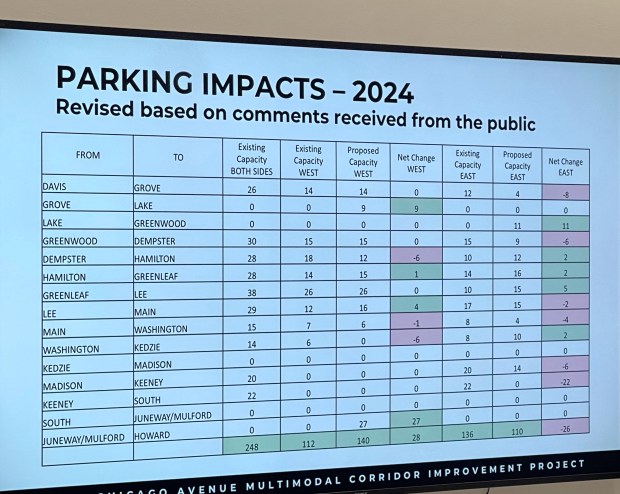Evanston residents and business owners at a Dec. 10 meeting passionately expressed opposing views to city leaders on a proposed bike lane that would run along Chicago Avenue from Evanston’s downtown to its southern border.
City Council Member Melissa Wynne, whose 3rd Ward contains much of the impacted stretch of Chicago Avenue, said the city of Evanston hosted the packed meeting, held at the Robert Crown Community Center, to address the community’s concerns and to fine-tune the proposed bike lane, which she said has been in the planning stages since 2020.
Evanston officials say that misinformation was put out to the public saying the bike lanes would cause a loss of parking spaces for cars. Acknowledging that this may have stirred the ire of some business owners and residents, the officials stated the proposed bike lane plan will actually increase street parking for residents and shoppers by two parking spaces.
“Tonight’s meeting was in response to a lot of misinformation circulating in the community that we’re stripping parking off of the east side of Chicago Avenue, which was never the plan,” Wynne told Pioneer Press after the meeting concluded. Wynne did not identify the person who spread that information.
A chart officials presented at the meeting showed gains or losses of parking spaces in various segments of the Chicago Avenue route. For example, the stretch between South Boulevard and Keeney shows a loss of 22 parking spaces. The stretch between Howard Street and Juneway/Mulford shows a gain of 27 spaces. Over the entire stretch, the plan would add two spaces over the existing 248 parking spaces.
A block by block breakdown of the proposal can be found on the city’s website.
According to Wynne, the proposed bike lane is an extension of the existing Chicago Avenue bike lane north of downtown, from Davis Street to Sheridan Road, and is part of a bigger overhaul of Chicago Avenue that will be in compliance with ADA laws and include new street lights, traffic signals, repaired sidewalks and repaved road. The total cost of the project is approximately $13 million, she said, with the city applying for federal grants to cover 80% of the cost.
Although outnumbered by supporters of the bike lane, business owners also spoke up at the meeting.
“There’s 200 businesses just between Main and Dempster (along Chicago Avenue),” said Carney Minasian, owner of Minasian Rug Company, located near Chicago Avenue and Dempster Street. “I think the impact is going to be serious. There’s a lot of small businesses that count on people just parking in front of their stores.”
Wynne said that it was possible that misinformation could have also spread from a previous proposal the city was considering for the bike lane. The city’s first draft of the bike lane from 2023, which has been ditched since, permanently removed 66 parking spaces from Chicago Avenue, she said, widened sidewalks and widened entrances to the bike lane from driveways.
“The engineering department went back and scrubbed this plan more in response to our concerns,” Wynne said. She said the current proposal shifted the parking spaces along Chicago Avenue, kept the sidewalks at their current width, reduced the entrances to the bike lanes from driveways and added two parking spaces in the corridor.
“That doesn’t mean every parking space will stay where it is on the street. But it does mean that the net total of parking spaces from Davis to Howard goes up by two,” Wynne said. She added that the city’s plan is still tentative, and that the city is still open to suggestions and comments that could alter the city’s design.
Wynne said the current proposal also includes designated loading zones on every block that allows parking for 15 minutes to allow delivery drivers to stop and unload their goods.
Lara Biggs, the city’s engineer, said Chicago Avenue has been designated by the city as a bike route since 2014. “There has been a complete and green streets policy that says we must consider all the uses of the street when we do a street improvement, particularly on arterial streets like Chicago Avenue, which includes pedestrians and bicyclists.”
“Our focus is really about safety, looking at accident data, trying to make it safer for everybody,” Biggs said.
Biggs said the city has been steadily moving forward with the project, and has conducted 18 meetings with stakeholders and two larger community meetings, with most meetings having taken place in 2021.
Biggs said that the process has taken as long as it has because the city is asking for federal funds. “We spent a lot of time talking to people in the public engagement phase at the beginning, and then we go away for a couple of years and do our work until we bid it and get it under construction, and then that’s when people again interact with it.”
“That is just an unfortunate evil of doing really big projects,” Biggs said.

Cycling advocates also spoke up at the meeting. Gabe Weiss and Sarah Hanson spoke in favor of the bike lanes for what they saw as a sustainable way for people to get around in Evanston. Hanson said she was interested in seeing the biking network in Evanston expand, likening it to cities like Amsterdam and Vancouver. Weiss said he was also in favor of protected bike lanes, also to increase safety for cyclists.



